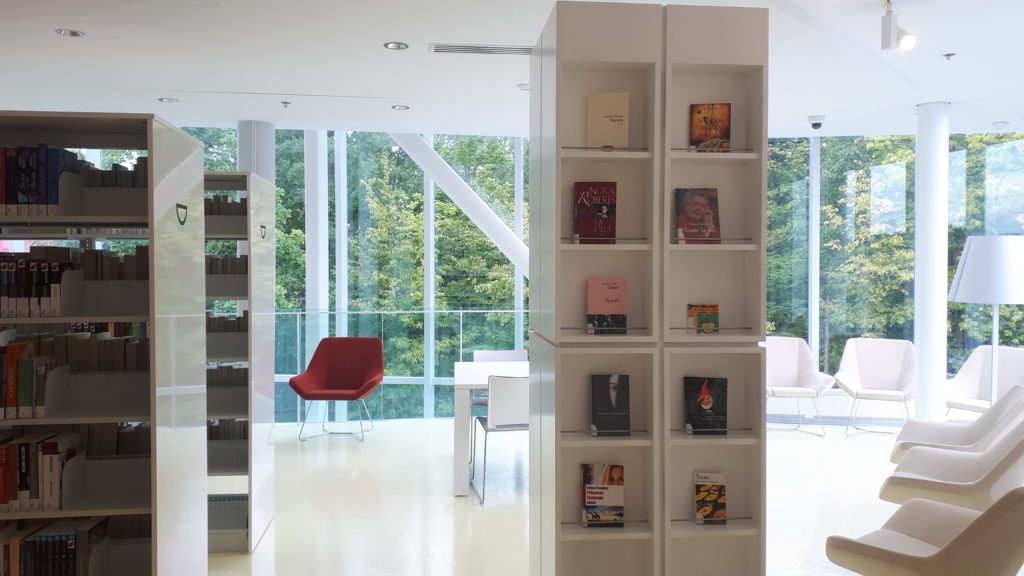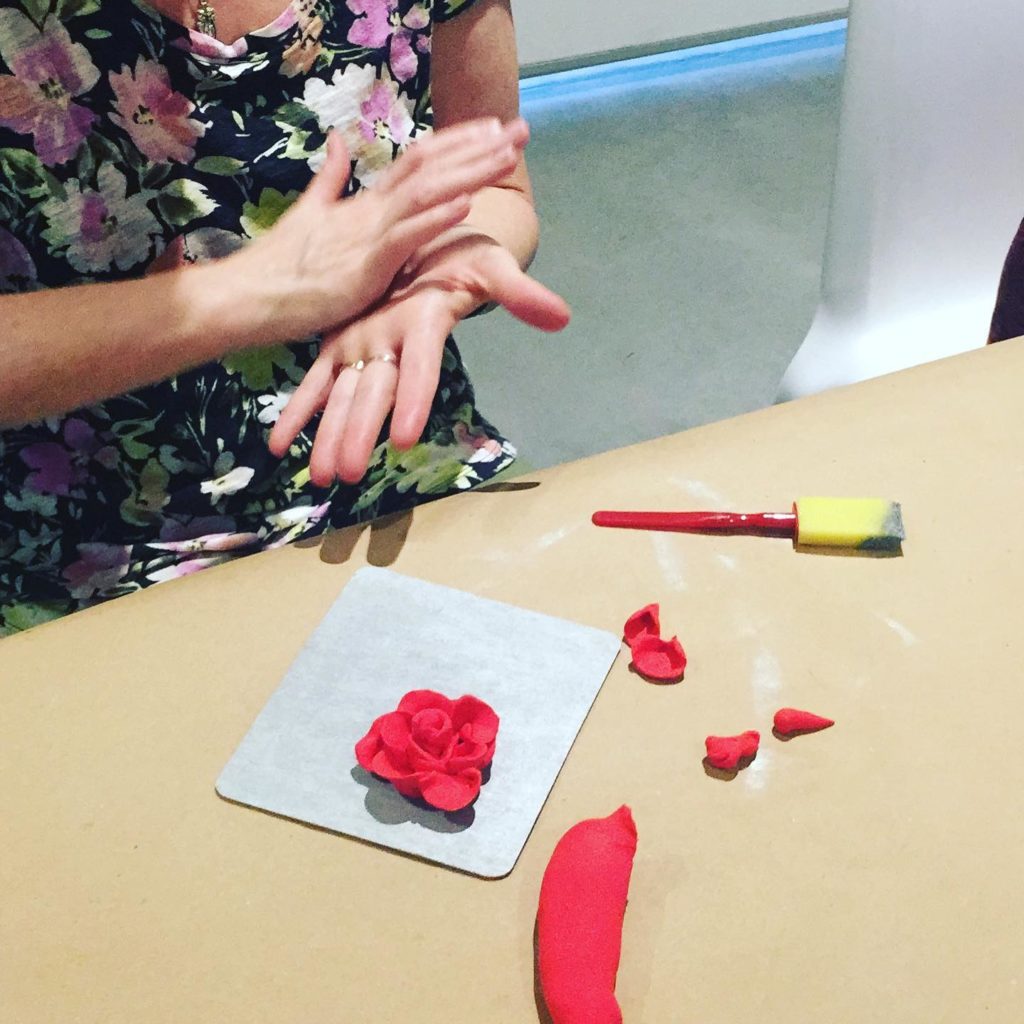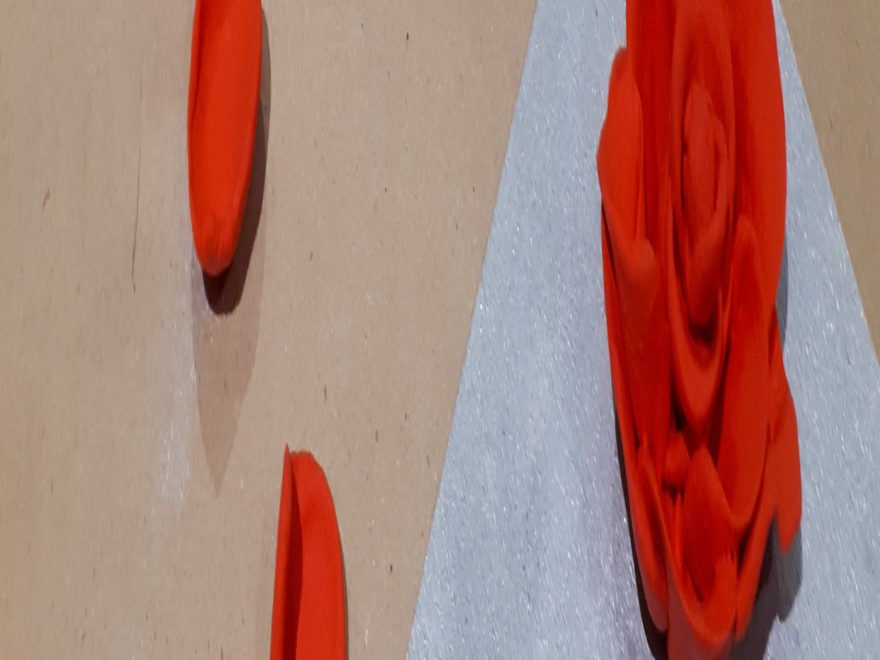After my experience as a patient-participant at Play the Pain earlier this month, I was curious to try something new at a two-hour art workshop today. It was being given – for free! – at my local library. This library re-opened just this past spring, after having been completely renovated and extended; it’s now an absolutely stunning public space.

Have I intrigued you yet? Are you wondering what type of creative art this workshop touched on? It was to learn how to make clay flowers, a basic introduction to this art form.
The session was led by a lovely woman who usually teaches much more in-depth courses on clay art, using sculpting knives. That’s a five-day course, though, so obviously not what we’d be trying in a two-hour session! Bhawna also teaches courses in candle-making; she has a very artistic and creative soul.(1)
As always, I arrived a bit early; I never know when any of the multiple symptoms of my rare disease are going to act up, more than usual, so I’ve taken to adding extra time to all of the plans I make. One positive aspect of arriving early is that I’ll often have time to chat with organizers or presenters, if they’re open to conversation. She was ‘-)
I mentioned to Bhawna that I can’t really use my right hand, due to Complex Regional Pain Syndrome (CRPS), and that she’d likely see me trying to adapt some of her workshop instructions to using my ‘wrong’ hand. So, of course, we had a little chat about this rare condition.
You know me, I’ll raise awareness of CRPS at any opportunity! She was recovering from an elbow injury, so was particularly interested in my dynamic splint. It looks like a movie-character’s claw, and often makes a great conversation-starter. I’m lucky in that my thumb isn’t affected by CRPS, so my ‘claw’ is only for the four fingers.
The workshop was a lot of fun, and the two hours passed in the blink of an eye. There were only ten participants, so we each got some one-on-one teaching. Although I wasn’t thrilled with how my clay flowers turned out, I have to admit that the end result was much better than what I had expected. After all, I was mostly using left hand – and I’m right-handed.

This photo shows my five best attempts at making clay flowers; two roses, a rosebud, a creative poppy-like flower – as Remembrance Day is coming up on November 11th – and what I called my ‘pain flower’. As we approached the end of the workshop, Bhawna had encouraged us to be more creative, to come up with an imaginary flower.
By the end of this two-hour session, my right hand was in excruciating pain. Even though I’d barely involved my fingers, using only my right palm to roll the pieces of clay between my hands, the joint pain and neuropathic pain had begun to flare. Surprisingly, the allodynia still wasn’t acting up.
So I decided to try to give shape to the pain that I was feeling, and that spiky flower was the result. It’s not very pretty, which is fitting because CRPS pain really isn’t all that pleasant either! Even though this wasn’t a formal art therapy session, Bhawna and I had discussed this aspect of creative pursuits.
More important than these clay flowers, to me, was the experience itself. First off, it was entertaining; even when some of my flowers flopped over and I had to start again, it was still fun to see what the clay shapes would do. Second, I learned something new, something different. I’ve always been a relatively creative person, and enjoy making things myself.
This has ranged from embroidery, sewing (even sewing some Halloween costumes, with no patterns!), and other needlework, to fancy decoration on cupcakes. My beloved grandmother and my mother were both seamstresses, and one of my grandfathers was a wonderful amateur artist who worked with oil paints, pastels, and watercolours.
My other grandfather made gorgeous woodwork projects, including a wall-mounted grandfather clock – which is still on the wall of my home. He made it for me in 1988. So I grew up in a house. My mom’s sister has been a member of so many creative guilds that I’ve lost track.
This aunt has mastered, and teaches, several different types of needlework, beading, and metal work. She also works with gemstones, cutting and polishing stones to incorporate into the jewelry she makes. When she retired, many years ago, her artistic works became more or less her full-time job.
She does all of this for fun, selling her creations to cover the costs of supplies… so that she can complete more of these types of projects, and try new techniques. And she has just signed up for a new course, to learn to work with precious metal clay. In terms of creativity, this aunt is my idol!
Meanwhile another one of my aunts, from my dad’s side of the family this time, started taking drawing and painting courses a few years ago. She has already progressed to creating some gorgeous works. So, as you can imagine, creativity really is something of a family tradition for me!
Back to today’s session… The third thing I loved about the clay flower workshop was the clay itself. It was much softer than any clay I can recall using in high school art classes, with a springy texture. Almost like a slightly softened, but not sticky, marshmallow. The unworked clay felt almost warm to the touch, practically alive.
When I tried holding this clay in my right hand, it didn’t trigger my allodynia at all. Allodynia is a common symptom of CRPS; it’s an extreme sensitivity of the skin, a specific type of neuropathic or nerve pain. The International Association for the Study of Pain (IASP) defines allodynia as: “Pain due to a stimulus that does not normally provoke pain”.(2)
A gentle touch, a light pressure, even the kiss of clothing against the skin, can cause the allodynia of my hand and lower arm to flare up. What’s interesting for this post is that “allodynia involves a change in the quality of a sensation, whether tactile, thermal, or of any other sort.”(2)
There was obviously some tactile quality to this clay which prevented it from triggering my allodynia. It was an odd sensation for me to be able to hold this clay in my right hand, and to be able to slightly move my fingers through it, without feeling intense neuropathic pain. A feeling that I’d all but forgotten since I was struck with this condition.


www.facebook.com/pg/AtelierCandleCloud/about
When I asked Bhawna about it, she told me that it was a special clay from Korea. Apparently the art of making clay flowers is very popular there, although it originated in Japan. She had brought this Korean art clay back with her, from a recent trip, but said that I might be able to order some through a local art supply shop.
Can you guess the fourth thing that made this workshop so much fun? Come on, you can do it! It was our instructor, Bhawna. We could see the passion she had for this art form, and in sharing it with us. And she was so excited for each of us, as we saw our creations come to life under her guidance.
This clay flower workshop was absolutely fantastic. If you’re in the Montreal area, I highly recommend it! This is a 100% non-commercial website, but I’m comfortable making this recommendation because the workshop I attended was a free public event (although registration was required, through the municipal library)!
To Bhawna – Thank you so much for making this workshop an almost-art therapy session for me! And for giving me a piece of this clay to take home; to play with, and to bring to an art supply shop so I can try to order some for my own version of individual art therapy ‘-)
To everyone else – Thanks so much for reading, for sharing this journey with me as a rare disease and chronic pain patient. I wish you… beauty in your day, hope in your heart, and joy in your spirit!
References:
(1) Atelier Candle Cloud posts to Instagram at @AtelierCandleCloud and to the internet (on FaceBook) at https://www.facebook.com/pg/AtelierCandleCloud/about
If you use either of these apps, this is a reminder to keep your privacy settings up-to-date!
(2) IASP Terminology: Allodynia. International Association for the
Study of Pain. Online: Updated 14 Dec 2017, from “Part III: Pain Terms, A
Current List with Definitions and Notes on Usage” (pp 209-214) Classification
of Chronic Pain, Second Edition, IASP Task Force on Taxonomy, edited by H.
Merskey and N. Bogduk, IASP Press, Seattle, ©1994. Accessed 28 Oct 2019:
https://www.iasp-pain.org/Education/Content.aspx?ItemNumber=1698

